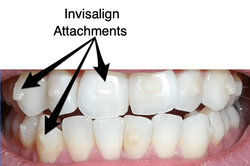Success Stories: How Invisalign Changed Lives and Boosted Confidence
Success Stories: How Invisalign Changed Lives and Boosted Confidence
Blog Article
Invisalign vs. Traditional Braces: Which Option Is Right for You?
When taking into consideration orthodontic therapy, the option in between Invisalign and traditional braces offers a number of important aspects that merit cautious examination. Invisalign uses a very discreet option with detachable aligners, while conventional dental braces offer a more noticeable yet reliable solution for serious imbalance. Each choice includes distinct benefits and downsides associated to looks, comfort, treatment period, and expense. Recognizing these subtleties is essential for making an informed choice that lines up with your personal preferences and way of living. The question continues to be: which alternative will ideal satisfy your orthodontic demands and expectations?
Introduction of Therapy Options

On the other hand, conventional braces contain metal braces and cables that are bound to the teeth. This technique applies continual pressure gradually to attain positioning. While effective for intricate orthodontic problems, typical dental braces need normal check outs for adjustments and can posture difficulties in preserving dental hygiene as a result of the problem of cleaning up about braces and cords.
Both choices have their qualities, and the selection usually depends upon details oral conditions, way of life preferences, and patient conformity. Eventually, consulting an orthodontic expert is important for establishing the most suitable treatment strategy customized to private demands. Recognizing the nuances of each option can substantially affect the total success of orthodontic treatment.
Aesthetic Factors To Consider
A substantial aspect influencing the choice in between Invisalign and typical braces is the aesthetic charm each treatment supplies. Invisalign aligners are crafted from clear plastic, making them basically undetectable when put on.
In comparison, typical dental braces include steel brackets and wires, which can be a lot more visible. While innovations in orthodontic technology have actually led to the growth of smaller sized brackets and tinted elastics, conventional braces still preserve a more obvious profile. For some individuals, the exposure of dental braces may deter them from seeking necessary therapy.
Ultimately, the choice in between Invisalign and conventional dental braces might rest on personal preferences relating to looks. Clients that prioritize discernment typically favor Invisalign, while those that are less concerned about visibility might opt for traditional braces. Understanding the visual effects of each alternative is vital for making a notified decision that straightens with one's way of living and choices.
Comfort and Convenience

In terms of ease, Invisalign aligners are removable, enabling people to enjoy their favored foods without restriction and keep optimum oral health. Brushing and flossing are streamlined, as the aligners can be gotten throughout these regimens, look here whereas traditional dental braces need careful steering around braces and wires.
In addition, Invisalign's progressive system permits fewer orthodontic sees. Patients usually obtain several collections of aligners at when, which can improve the treatment procedure and lower time invested in the orthodontist's chair. In contrast, conventional dental braces require routine modifications, making them less convenient for those with hectic timetables. Invisalign. On the whole, the convenience and ease of Invisalign make it an attractive choice for several people looking for orthodontic treatment.
Therapy Period and Efficiency
While both Invisalign and conventional braces work in correcting dental imbalances, the duration of therapy can differ substantially between the 2 choices. Typically, Invisalign therapy can take anywhere from 12 to 18 months, depending upon the complexity of the case. The clear aligners function by slowly shifting teeth into their wanted positions, and normal follow-ups with an orthodontist assistance guarantee development remains on course.
In comparison, standard dental braces typically need a longer dedication, normally varying from 18 months to three years. This is due to their fixed nature and using cords and brackets, which can be extra effective for serious imbalances and intricate situations (Invisalign). The treatment performance of conventional braces is well-documented, as they enable accurate changes and better control over tooth motion
Eventually, the selection between Invisalign and typical dental braces may hinge on both the expected therapy duration and the specific dental concerns at hand. Consulting with an orthodontist is crucial, as they can give tailored suggestions based upon individual demands, making certain the chosen method aligns with wanted durations and results.
Expense Comparison and Insurance Coverage Choices
Price plays a considerable function in the decision-making process for individuals taking into consideration orthodontic therapy, whether choosing for Invisalign or traditional dental braces. On average, the expense of Invisalign varieties from $3,000 to $8,000, while traditional braces typically set you back between $2,000 and $6,000. Variables affecting these costs include the complexity of the instance, the duration of therapy, and geographical place.
Numerous dental insurance policy strategies give partial protection for orthodontic visit therapies, however the specifics can differ widely. Usually, conventional braces may be extra frequently covered by insurance policy plans compared to Invisalign, which some insurers classify as a cosmetic procedure.
Additionally, a number of orthodontic techniques use versatile repayment plans, making both treatment alternatives extra available. Individuals ought to make inquiries regarding prospective financing options and discount rates for ahead of time settlements. Examining the total expense, consisting of insurance advantages and payment strategies, is crucial for making an educated choice that straightens with both aesthetic preferences and budget plan considerations.

Conclusion
In summary, the choice between Invisalign and traditional dental braces depends upon numerous factors, including aesthetic preferences, comfort, treatment period, and cost. Invisalign uses a discreet, detachable choice that helps with dental hygiene and nutritional Visit This Link versatility, while conventional braces might be better for complicated dental problems and usually come at a reduced cost point. Eventually, consultation with an orthodontist is necessary to analyze individual scenarios and identify the most ideal therapy option for attaining optimum oral placement.
When considering orthodontic therapy, the selection between Invisalign and traditional dental braces provides numerous essential variables that warrant cautious examination.Comparing Invisalign and traditional braces reveals distinctive treatment options for orthodontic modification.While both Invisalign and standard braces are efficient in correcting dental misalignments, the period of treatment can vary dramatically between the 2 options.Price plays a significant role in the decision-making procedure for people considering orthodontic treatment, whether opting for Invisalign or traditional dental braces.In summary, the option in between Invisalign and conventional braces pivots on several elements, consisting of visual choices, convenience, therapy period, and cost.
Report this page